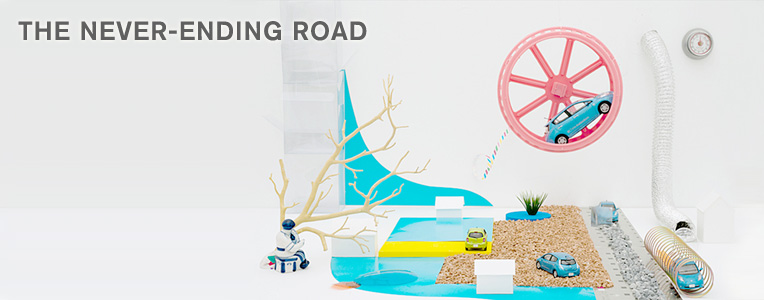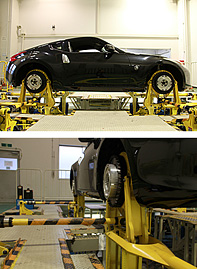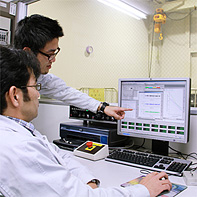The Never Ending Road

It stretches out as far as your eyes can see. Along this long road drives a car, each and every day, twenty-four seven. And yet it cannot even see its destination...
Day and night, the road simulator knows no rest in its ceaseless quest to test Nissan vehicle durability. This might well be a car mounted onto a large inside mechanical platform, but it's set up to create wheel and suspension load just as if the car was driving on an actual road. Through simulating driving motion for thousands of kilometers, and analyzing the impact from bad road surfaces and the deterioration of car parts, the machine helps perfect a car that will last longer in the real world.
In previous durability trials the only real method to test out a car was to have a driver actually drive the vehicle for tens of thousands of kilometers on a special course. Now we have this kind of road simulator that can test multiple kinds of axial load and recreate global road conditions. Want to test just the front of the car or the suspension? It can run focused tests. Want to test different tires? Of course, no problem! Even a completely new kind of model like Nissan LEAF could be "driven" tens of thousands of kilometers to test its durability.

The road simulator being used to test a car's durability.
Data collected from driving on the Nissan test drive courses at Tochigi and Oppama can be inputted into the road simulator. Nissan conducts market surveys all over the world, giving it know-how on all manner of global road surfaces, which can then be recreated twenty-four seven on this simulator. Based on its research into the ways cars are used throughout the globe, Nissan has made the Reliability Assurance Standards. These are the foundation of its tests with the road simulator, but each trial also works to improve the Standards. In other words, the more Nissan's engineers test and simulate, the better the durability of the vehicles will become.
The best thing about the simulator is not just that now test drivers don't have to get bad backs. The real beneficiaries are the customers, who can buy cars that are even more reliable and durable. Unlike a regular test driver and course scenario, the road simulator can conduct multiple data readings simultaneously and obtain results more accurately. If, for example, some parts come loose, the team behind the road simulator, the Body and Chassis Reliability Test Group, can judge the cause through analyzing the data, reporting that feedback to the design team to fix defects or weak areas.
These engineers are the navigators for the simulator's long journeys: Their expertise lies in taking the data measured with an actual test car and then recreating the movement of a vehicle based on how a customer would use it. They consider how best to faithfully imitate outside environment conditions, such as using fans to generate "wind" effects, making sure the results they get are always as accurate as a "real" drive.
For Nissan, "durability" means that up until when they finally let go of their cars, its customers should never be failed by their vehicles. It's the unrelenting voyage of the testers and their road simulator to seek out the level of quality that can make this a reality. Following further tests in the outside world, the simulator's "road" finally ends when customers take the driving seat for themselves. Then begins the real journey on Nissan's never-ending highway.

Engineers Hitoshi Tabata and Yushi Sakai from the Body and Chassis Reliability Test Group observe test results on their monitors in real time while the road simulator is in use.

